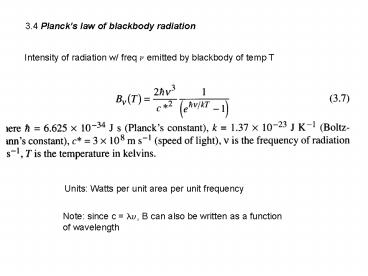3'4 Plancks law of blackbody radiation - PowerPoint PPT Presentation
1 / 13
Title:
3'4 Plancks law of blackbody radiation
Description:
... Planck's law of blackbody radiation. Intensity of radiation w/ freq emitted by blackbody of temp T ... A property of Planck's law is that the wavelength of ... – PowerPoint PPT presentation
Number of Views:460
Avg rating:3.0/5.0
Title: 3'4 Plancks law of blackbody radiation
1
3.4 Plancks law of blackbody radiation
Intensity of radiation w/ freq ? emitted by
blackbody of temp T
Units Watts per unit area per unit frequency
Note since c ??, B can also be written as a
function of wavelength
2
A property of Plancks law is that the wavelength
of maximum emission is inversely proportional to
the temperature (known as Wien displacement
law) ?max ? 2898 / T (T in K, wavelength in ?m)
3
It means that the solar radiation (shortwave, or
SW) and terrestrial radiation (longwave, or LW)
occupy different intervals in the spectrum - it
justifies separate treatment of SW and LW.
4
(source CookGierasch)
5
Note that the Stefan-Boltzmann law is just the
flux density computed from B, assuming that
blackbody radiation is isotropic (independent of
angle)
Source KKC
6
(source PO fig 4.2)
3.5 Selective absorption and emission by
atmospheric gases
7
- Quantization radiative energy is absorbed and
released by atoms and molecules in discrete
energy levels - Absorption by atom/molecule stored in one of
several ways - Translational energy (continuous) - generally
small compared to vibrational energy, but is
important in spectral broadening - Rotational energy (discrete) - corresponds to
wavelengths shorter that 1cm. Requires a dipole
moment - Vibrational energy (discrete) - corresponds to
wavelengths less than 20 micrometers - Photodissociation - photon breaks the bond that
hold together atoms in a molecule, wavelengths
less than 1micrometer. E.g. Ozone dissociation
and the 200-300nm band - Electronic excitation (discrete) - corresponds to
energy wavelengths lt 1 micrometer. Electrons
are excited to the outer shell of the atom - Photoionization - atom loses electron
wavelengths less than 100nm
8
Rotational and vibrational modes are generally
the most important for troposphere
CO2 vibration-rotation mode important at 15?m
(LW) Water vapor has a important
vibration-rotation mode near 6.3 ?m, and densely
spaced rotational bands in excess of 12 ?m. The
region between the two is called the water vapor
window, as it is relatively transparent to LW
9
3.5.7 Absorption lines and line broadening
Pressure (collision) broadening Broadening due to
collision between atoms/molecules - most
important in the troposphere where air is
dense Doppler broadening Due to motion of
atoms/molecules relative to observed. Important
where air is thin (high altitudes) Natural
broadening Due to quantum mechanical effects
(transition lifetimes, uncertainty principle)
10
- Important points
- N2 and O2 (which make up most of the atmosphere)
does not produce dipole moments even when
vibrating - so there are no rotational-vibrational
modes at small energies corresponding to LW.
So, the molecules important for LW radiative
transfer on Earth are the trace constituents
(water vapor, carbon dioxide, ozone). - Apart from the 8-12?m range, the atmosphere is
opaque to terrestrial LW. Important lines are
water vapor 6.3 ?m, ozone 9.6 ?m, carbon dioxide
15 ?m - The atmosphere is almost transparent to SW.
Exceptions are the UV radiation (lt0.2 ?m) that
are absorbed by photodissociation and ionization
of N2 and O2 in the upper atmosphere, and 0.2-0.3
?m that is absorbed by ozone in the stratosphere
11
Absorption of radiation
12
(No Transcript)
13
Solar flux
?
0
z
1
What is optical depth? Its another way to
represent the vertical co-ordinate, but it has
the special property that the flux drops by a
factor 1/e for every unit of optical depth
traversed. Optical depth has no units.
2
F0/e
F
F0/e2
F0

